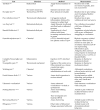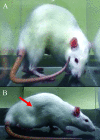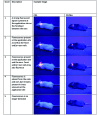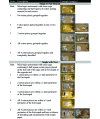A Review of Pain Assessment Methods in Laboratory Rodents
- PMID: 31896391
- PMCID: PMC6935698
- DOI: 10.30802/AALAS-CM-19-000042
A Review of Pain Assessment Methods in Laboratory Rodents
Abstract
Ensuring that laboratory rodent pain is well managed underpins the ethical acceptability of working with these animals in research. Appropriate treatment of pain in laboratory rodents requires accurate assessments of the presence or absence of pain to the extent possible. This can be challenging some situations because laboratory rodents are prey species that may show subtle signs of pain. Although a number of standard algesiometry assays have been used to assess evoked pain responses in rodents for many decades, these methods likely represent an oversimplification of pain assessment and many require animal handling during testing, which can result in stress-induced analgesia. More recent pain assessment methods, such as the use of ethograms, facial grimace scoring, burrowing, and nest-building, focus on evaluating changes in spontaneous behaviors or activities of rodents in their home environments. Many of these assessment methods are time-consuming to conduct. While many of these newer tests show promise for providing a more accurate assessment of pain, most require more study to determine their reliability and sensitivity across a broad range of experimental conditions, as well as between species and strains of animals. Regular observation of laboratory rodents before and after painful procedures with consistent use of 2 or more assessment methods is likely to improve pain detection and lead to improved treatment and care-a primary goal for improving overall animal welfare.
Figures








Similar articles
-
Ethical and IACUC Considerations Regarding Analgesia and Pain Management in Laboratory Rodents.Comp Med. 2019 Dec 1;69(6):443-450. doi: 10.30802/AALAS-CM-18-000149. Epub 2019 Aug 27. Comp Med. 2019. PMID: 31455464 Free PMC article.
-
Clinical Management of Pain in Rodents.Comp Med. 2019 Dec 1;69(6):468-489. doi: 10.30802/AALAS-CM-19-000048. Epub 2019 Dec 10. Comp Med. 2019. PMID: 31822323 Free PMC article. Review.
-
Use of behavior analysis to recognize pain in small mammals.Lab Anim (NY). 2007 Jun;36(6):43-8. doi: 10.1038/laban0607-43. Lab Anim (NY). 2007. PMID: 17519944
-
Rodent analgesia: Assessment and therapeutics.Vet J. 2018 Feb;232:70-77. doi: 10.1016/j.tvjl.2017.12.017. Epub 2017 Dec 23. Vet J. 2018. PMID: 29428096 Review.
-
Pain and distress in research animals: a panel of experts debates the issues.Lab Anim (NY). 2002 Jan;31(1):34-42. doi: 10.1038/5000115. Lab Anim (NY). 2002. PMID: 11910397 No abstract available.
Cited by
-
Refinement of the motorised laminectomy-assisted rat spinal cord injury model by analgesic treatment.PLoS One. 2024 Jan 16;19(1):e0294720. doi: 10.1371/journal.pone.0294720. eCollection 2024. PLoS One. 2024. PMID: 38227583 Free PMC article.
-
Development and validation of a mouse model to investigate post surgical pain after laparotomy.Surg Open Sci. 2024 Jun 18;20:106-115. doi: 10.1016/j.sopen.2024.06.002. eCollection 2024 Aug. Surg Open Sci. 2024. PMID: 39021615 Free PMC article.
-
Evaluation of Pain and Distress and Therapeutic Interventions for Rectal Prolapse in Mice to Reduce Early Study Removal.J Am Assoc Lab Anim Sci. 2021 Nov 1;60(6):692-699. doi: 10.30802/AALAS-JAALAS-21-000038. Epub 2021 Nov 8. J Am Assoc Lab Anim Sci. 2021. PMID: 34749842 Free PMC article.
-
Exploring Serum Biomarkers for Neuropathic Pain in Rat Models of Chemotherapy-Induced Peripheral Neuropathy: A Comparative Pilot Study with Oxaliplatin, Paclitaxel, Bortezomib, and Vincristine.Toxics. 2023 Dec 8;11(12):1004. doi: 10.3390/toxics11121004. Toxics. 2023. PMID: 38133405 Free PMC article.
-
A single intraarticular injection of a tranexamic acid-modified hyaluronic acid (HA/TXA) alleviates pain and reduces OA development in a murine model of monosodium iodoacetate-induced osteoarthritis.Front Pharmacol. 2024 Sep 11;15:1456495. doi: 10.3389/fphar.2024.1456495. eCollection 2024. Front Pharmacol. 2024. PMID: 39323636 Free PMC article.
References
Publication types
MeSH terms
LinkOut - more resources
Full Text Sources

